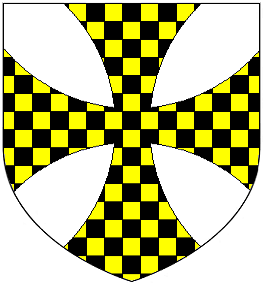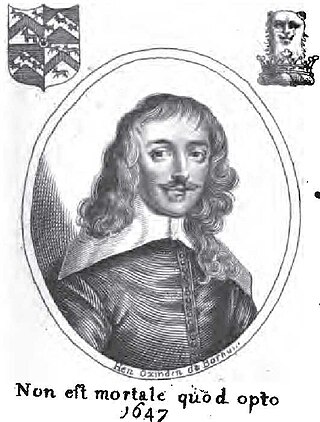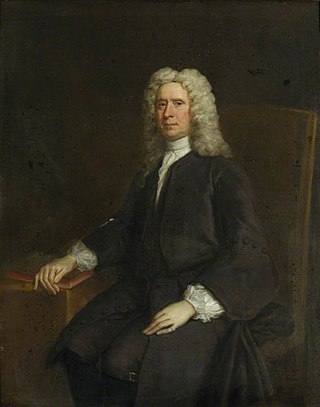
John Dixwell, alias James Davids, c. 1607 to 18 March 1689, was an English lawyer, republican politician and regicide. Born in Warwickshire, during the Wars of the Three Kingdoms he held various administrative positions in Kent on behalf of Parliament, and approved the Execution of Charles I in January 1649. Under the Commonwealth, he served as Governor of Dover Castle, and was a member of the English Council of State.

Baron Wenlock is a title that has been created three times, once in the Peerage of England and twice in the Peerage of the United Kingdom. The first creation came in 1461 when the soldier Sir John Wenlock was summoned to Parliament as Lord Wenlock. However, he was childless and on his death in 1471 the title became extinct.
Sir Isaac Astley, 1st Baronet was an English baronet.

There have been twenty one baronetcies created for persons with the surname Williams, eight in the Baronetage of England, three in the Baronetage of Great Britain and ten in the Baronetage of the United Kingdom. Only six of the creations are extant as of 2017.
There have been three baronetcies created for members of the Mosley family, one in the Baronetage of England and two in the Baronetage of Great Britain. Only one creation is extant. Since 1980, the title has been held jointly with Baron Ravensdale in the Peerage of the United Kingdom.

There have been two baronetcies created for different branches of the Throckmorton family, 6th cousins, both descended from Sir John Throckmorton, Under-Treasurer of England temp. King Henry VI (1422–1461). Both titles, which were in the Baronetage of England, are now extinct. The Throckmortons, originally of Throckmorton near Pershore, Worcestershire, trace their history back to the 12th century. In 1409 Sir John de Throckmorton, Under-Treasurer of England, married Eleanor Spinney, daughter and heiress of Guy Spinney of Coughton, Warwickshire, where the senior branch of the family, which bore the junior baronetcy, became established. The Coughton estate included in 1968 a dower house named "Spiney House, Coughton", named after that family. The senior Throckmorton Baronetcy, of Tortworth in the County of Gloucester, was created in the Baronetage of England on 29 June 1611 for William Throckmorton, of Coss Court, Tortworth, Gloucestershire, sixth in descent from John Throckmorton, younger son of Sir John Throckmorton, Under-Treasurer of England. The third Baronet sat as Member of Parliament for Gloucestershire and Wotton Basset. The title became extinct on the death of the fourth Baronet in a duel in 1682.
There have been two baronetcies created for members of the Puckering family.

The Holte Baronetcy, of Aston in the County of Warwick, was a title in the Baronetage of England. It was created on 25 November 1611 for Sir Thomas Holte, of Aston Hall, then in Warwickshire. He was High Sheriff of Warwickshire in 1599 and had been knighted by King James I in 1603. He was succeeded by his grandson, the second Baronet. He was Member of Parliament for Warwickshire. The third and sixth Baronets also represented Warwickshire in Parliament while the fifth Baronet was Member of Parliament for Lichfield. The title became extinct on the death of the sixth Baronet in 1782 and the substantial estate was broken up, under an Act of Parliament of 1817, in order to meet the interests of the various claimants.

There have been three Baronetcies created for persons with the surname Seymour, two in the Baronetage of England and one in the Baronetage of the United Kingdom. One creation is extant as of 2008.
There have been three baronetcies created in the Baronetage of England for members of the Skipwith family of Skipwith, Yorkshire, which relocated to Lincolnshire in the 14th century. They were a successful court family, with one member, Margaret Skipwith, seen as a possible queen of England after the death of Henry VIII's third wife, Jane Seymour. One creation of the baronetcy is extant as of 2008.

There have been three baronetcies created for persons with the surname Cooke, two in the Baronetage of England and one in the Baronetage of Ireland. One creation is extant as of 2013.
The Oxenden Baronetcy, of Dene in the County of Kent, was a title in the Baronetage of England. It was created on 6 May 1678 for Sir Henry Oxenden, previously Member of Parliament for Winchelsea, Kent and Sandwich. The second Baronet sat as Member of Parliament for Sandwich and Kent. His younger brother, the third Baronet, was Deputy Governor of Bombay. The fourth Baronet was the son of George Oxenden, Master of Trinity Hall, Cambridge, who was the third son of the 1st Baronet. He was Member of Parliament for Sandwich for over thirty years. The sixth Baronet inherited the Kentish estate of the Dixwell baronets at Broome Park which became the family seat. The title became extinct on the death of the tenth Baronet in 1924.

Sir John Cutler, 1st Baronet (1603–1693) was an English grocer, financier and Member of Parliament.
Sir Henry Oxenden, 4th Baronet was an English Whig politician who sat in the House of Commons from 1713 to 1720.
Sir George Oxenden, 5th Baronet was an English Whig politician who sat in the House of Commons from 1720 to 1754.

Sir Henry Oxenden, 1st Baronet (1614–1686) was an English politician who sat in the House of Commons at various times between 1645 and 1660.

George Oxenden was an English academic, lawyer and politician who sat in the House of Commons from 1695 to 1698.

Sir Thomas Peyton, 2nd Baronet, 18 August 1613 to 11 February 1684, was a member of the landed gentry from Knowlton Court in Kent. He supported the Royalists in the War of the Three Kingdoms, and took part in a number of conspiracies to restore Charles II of England during the 1649 to 1660 Commonwealth period.

Broome Park is a country house in Barham, within the City of Canterbury, Kent, England. It was built for Sir Basil Dixwell between 1635 and 1638. In the early 20th century it was the country home of Lord Kitchener of Khartoum until his death at sea in 1916. Now a country club, Broome Park is a Grade I listed building.
Sir Basil Dixwell, 1st Baronet (1585-1642), of Terlingham, Folkestone, Kent; formerly of Canterbury, Kent; later of Broome Park, Barham, Kent, was an English Member of Parliament.












